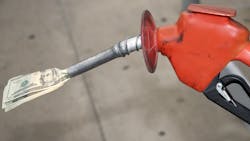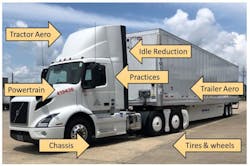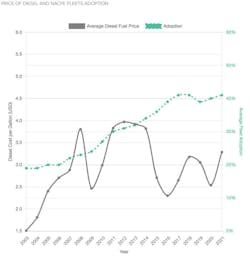Study: MPG improves as fleets adopt diesel-saving technologies
The ninth and latest update of the North American Council for Freight Efficiency’s Annual Fleet Fuel Study (AFFS) found that participating fleets continue to have their fuel economy climb when they adopt a host of fuel-saving technologies for their tractors and trailers and practices for their operations, NACFE officials said during the Dec. 13 reveal of the study's latest findings.
A top-line finding from the 2022 version of the NACFE study—which took a three-year break during the COVID-19 pandemic—found that average fuel economy among the 15 participating fleets has risen to 7.23 miles per gallon on their tractors as technology adoption has grown from 17% going back to 2003 to more than double—41%—in 2021. The 15 fleets in the AFFS operating 75,000 trucks saved $540 million in 2021 compared to average trucks on the road, NACFE added.
See also: Diesel drives fleet costs, freight market shifts
More data cited by the study: The 2020 national fuel-economy average for about 1.7 million tractors in over-the-road operation jumped in the last three years to 6.24 miles per gallon, according to Federal Highway Administration data, from 5.98 MPG. NACFE’s September 2017 Run on Less demonstration showed that tractor-trailers equipped with the best fuel-saving technologies could attain MPGs above 10 miles per gallon.
Another impetus for fuel-economy improvement, as noted in the summary of the 2022 results? “Fuel, whether it’s gas for our cars or diesel for our trucks, is damn expensive,” Mike Roeth, NACFE’s executive director, remarked during an online news conference on Dec. 13, a couple of hours after release of the 2022 findings.
The summary of the 2022 findings noted that diesel fuel averaged $3.29 per gallon in 2021, according to the U.S. Energy Information Administration, up from $2.24 in 2020, a 30% year-over-year rise. That was before EIA’s U.S. diesel average surged well above $5 this summer and fall. The average sits now at $4.754 (the lowest since the week of Feb. 28) after a 21.3-cent drop the week of Dec. 12, but trucking’s main fuel still is $1.105 per gallon more expensive than it was a year ago.
The study looked at levels of adoption of 86 fuel-saving technologies and practices among the 15 participating for-fire and private fleets and one truck stop chain, which were CFI, C.R. England, Frito-Lay, J.B. Hunt, Maverick Transportation, Mesilla Valley Transportation, NFI, Nussbaum Transportation, Paper Transport, Pilot Flying J, Pitt Ohio, Schneider, UPS Inc., U.S. Xpress, and Werner Enterprises. Most are FleetOwner 500: Top For-Hire Fleets or FleetOwner 500: Top Private Fleets. Since the ongoing study's start in 2012, 24 trucking fleets have participated, though over the study's course, some have dropped out.
One fleet still participating sees the value of continuing to do so.
“While it made sense for NACFE to delay gathering data for this report, I am excited it’s back because it is an important tool for fleets that are looking to operate in a more fuel-efficient manner," Rob Reich, executive VP and chief administrative officer for Schneider. "I look forward to this report and read it each year within days of it being published. It is important to Schneider’s efforts, and it can be a critical resource to any fleet or owner-operator as well as manufacturers and others who are working to improve Class 8 efficiency.”
Fuel efficiency flattens in the pandemic years
Though the study results for 2022 show a growing use of these fuel-saving technologies and practices, they also show that fleetwide fuel efficiency stalled from 2018 to 2021. Fuel efficiency increased by an average of 2% through the prior years of the study from 2011 to 2017, but the MPG average was flat at 7.24 from 2018 to 2021, the latest results show.
After receiving input from participating and other fleets, OEMs and other stakeholders, the study notes what likely is driving the flattening of the MPG average in those three years: Many fleets have increased their cruise and highway speeds and have cut the rate at which they govern speeds under 65 from 80% in 2016 to 62% in 2021, though a proposed federal speed-limiter rule may change this calculus in the future. The result of the increased speeds and reduced governing has been a “significant” increase in fuel consumption, with a 0.1 MPG hit for every 1 MPH increase in average speed, the study notes.
See also: Why the U.S. economy will avoid a recession, but freight will slow in 2023
Also, it adds, fleets are keeping their trucks longer, but OEMs have been bringing commercial vehicles with better fuel economy to market each model year. This decreases the number of new and more fuel-efficient trucks in the study. Fleets also have trimmed the adoption of optional fuel-efficiency features, though Phase 2 greenhouse gas regulations have required OEMs to bring base versions of trucks and engines to market with improved MPGs, particularly in 2017 and 2021 when compliance steps were required.
Though MPGs have leveled off, Roeth said, "We have a lot of fuel economy on diesel trucks that's left to harvest." He added: "We're starting to see the effect of regional haul in freight movement, less highway for-hire where the fuel economy tends to be higher."
Roeth also sought to dispel the myth that fleet decarbonization stops at those that are only seeking to adopt all-electric or fuel-cell electric commercial vehicles. "This study shows that [the participating diesel-burning fleets] are decarbonizing trucking with what they are doing."
The 2022 AFFS for the first time includes a new online benchmarking tool that any freight hauler can use to compare themselves to the fleets that participated in the study and the technologies and practices they adopted. The 2022 study, an executive summary of its findings, the data set that supported this year's conclusions, and results from the eight prior years of the AFFS can be downloaded after registration from NACFE's website.
About the Author
Scott Achelpohl
Managing Editor
Scott Achelpohl is a former FleetOwner managing editor who wrote for the publication from 2021 to 2023. Since 2023, he has served as managing editor of Endeavor Business Media's Smart Industry, a FleetOwner affiliate.



